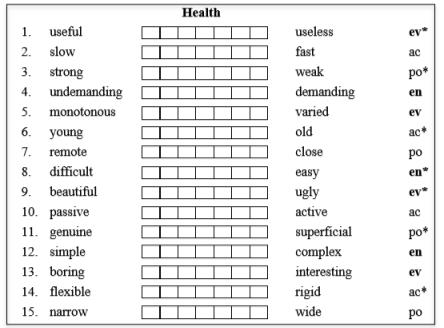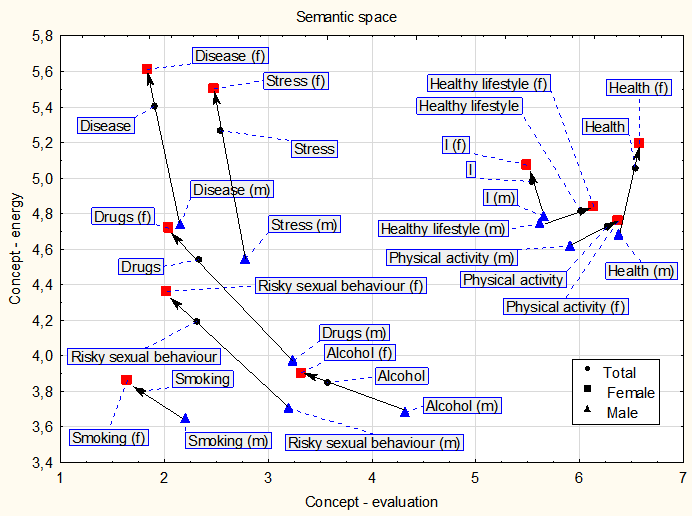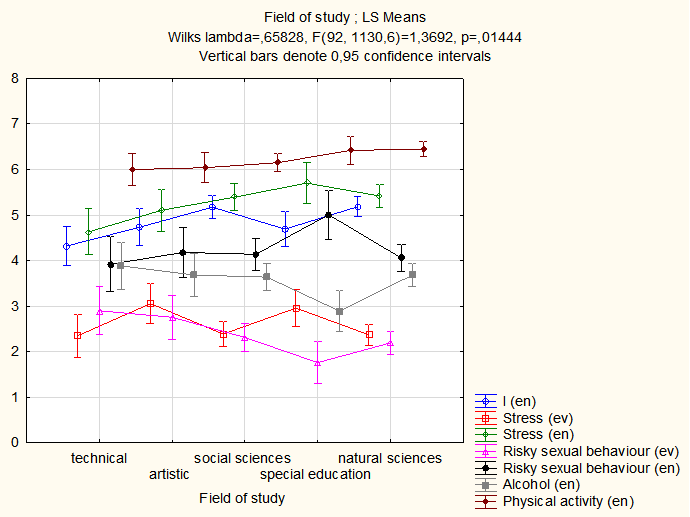Abstract
The paper describes the results of a research study investigating the attitudes of university students to concepts associated with health and healthy lifestyle by means of a semantic differential. Another objective was to compare these attitudes with the basic components of a healthy lifestyle. Specifically, these components included student-reported eating habits, leisure activity and physical activity. The research sample consisted of 612 university students enrolled in various teacher training programmes. The tool for the measurement of the students’ attitudes was a semantic differential of an own design using a factor analysis. To measure their attitudes to health and healthy lifestyle, the students were presented with the following concepts: I, Stress, Risky sexual behaviour, Drugs, Alcohol, Smoking, Health, Disease, Physical activity and Healthy lifestyle. The authors also investigated other students’ characteristics relating to the issue such as eating habits and preferred leisure activity and physical activity. Further indicators included the following: field of study, year of study, and gender. The obtained data were used to develop a semantic space to observe the concepts in various groups of respondents. The differences between various groups were further compared by means of the Student’s t-test and analysis of variance. It was revealed that men and women have different attitudes to health, and that students who highly value their health, healthy lifestyle and physical activity mostly adhere to healthy eating principles and engage in physical activity.
Keywords: Students’ attitudeshealthlifestylesemantic differentialfactor analysisANOVAt-test
Introduction
“When health is absent, wisdom cannot reveal itself, art cannot manifest, strength cannot fight, wealth becomes useless, and intelligence cannot be applied.” Heraclitus
This idea has been relevant for centuries and recently has gained special significance. Understanding the concept of health will make it easier to implement measures to promote health. Despite the general awareness about the importance of health and healthy lifestyle (Report on health, 2014), research (HBSC, 2016) suggests that in the Czech Republic the level of health is insufficient, health-related risks are underestimated, and pharmacological treatment is preferred over regime or diet related measures. According to the “Action plan to improve health literacy”, which should be included in the governmental document “Health 2020”, one of the six pillars of the plan in the Czech Republic should be education of pupils and students and also lifelong learning of teachers (Health 2020, 2014).
It is therefore necessary for future teachers to adopt desirable attitudes to health and healthy lifestyle, which will then be reflected not only in their educational activities but also in their own behaviour, which is for students a model of an adequate attitude (Hřivnová, 2016).
Problem statement
Attitudes of people and their behavioural tendencies shaped by the social conditions during the course of life appear as an important indicator of behaviour and experiencing. These attitudes are decisive for the behaviour of individuals also in important areas such as health and healthy lifestyle. One of the signs of a democratic society, which understands the health of its citizens as a value, is responsible and shared care for and interest in their health across all groups of individuals and all age cohorts. In this context, the authors were interested in the attitudes to health and healthy lifestyles of future teachers, who will have a crucial effect on health literacy of their students. The significance of the concept of health must be understood very broadly and in a holistic way, whether health is understood as a state (mental, physical, social) or a dynamic process subject to many circumstances (Holčík, 2009).
Research questions
The basic research question of the present research was: What are the attitudes of Czech university students to health and healthy lifestyle? This question was followed by other research questions: Do students’ attitudes differ by various fields of study? Do students’ attitudes differ by the actual year of study? Do students’ attitudes differ by gender? Do students’ attitudes correspond with their eating habits, leisure activity and physical activity?
Purpose of the study
The objectives of the present study are defined in two areas. The first area included the preparation and optimization of the modified semantic differential for Czech university students of teacher training programmes using a factor analysis. The aim of the second area was to investigate the attitudes to selected concepts associated with health and healthy lifestyle (biological and social component of health) at faculties where future teachers are educated. A total of 10 concepts were selected as indicators of the mentioned attitudes: I, Stress, Risky sexual behaviour, Drugs, Alcohol, Smoking, Health, Disease, Physical activity and Healthy lifestyle – see Table
Research methods - Semantic Differential
The semantic differential method, specifically the two-factor ATER version (Chráska sr., 2007) has been previously used by the authors to compare the attitudes of university students in the Czech Republic, Poland and Slovakia (Chrásková, 2016). It has been discovered however that simple acceptance of existing semantic differential scales is not always adequately transferable to other socio-cultural environments (Chráska jr. & Chrásková, 2016). The ATER measuring instrument was optimised by means of a factor analysis; however, in the present research the authors opted for the four-factor semantic differential (Pöschl, 2011), which was enriched with further scales of an own design.
Traditional semantic differential
The semantic differential (referred to as SD) is a research technique developed in 1950s in the USA by Professor Osgood (Osgood, 1957) for measuring individual psychological significance of words or attitudes to something. The method focuses on simple evaluations and is therefore particularly suitable for measuring emotional and behavioural aspects of attitudes. A great advantage is easy administration and relatively quick assessment. The basic dimensions of the semantic space were defined by C. Osgood using a factor analysis; a total of three most significant factors were identified. As a result, each concept is usually assessed in terms of the following three factors: factor of evaluation, factor of potency (power) and factor of activity.
Four-factor semantic differential
In the Czech Republic the issue of measuring students’ attitudes was addressed by Pöschl (2011), who developed a questionnaire for measuring attitudes using the method of a four-factor semantic differential. The significance of various concepts was mapped by means of thirteen seven-point assessment scales. Each scale was defined by a pair of opposing adjectives. The following four factors were identified by means of a factor analysis: factor of evaluation, factor of activity, factor of potency and factor of complexity.
The first three factors (evaluation, potency and activity) were consistent with those originally identified by Osgood. The fourth factor of “complexity” was represented by a single assessment scale (not included in the original Osgood’s list) and acts as a separate distinctive aspect.
Optimization of modified semantic differential
In the present research the authors adopted a modified semantic differential according to Pöschl (2011), which is based on the ATER semantic differential and enriched with scales measuring the energy of the concepts (marked en) – see Fig.
The data were obtained from the students by means of the scales of the modified semantic differential and subsequently subjected to a factor analysis in the STATISTICA Cz 12.0 programme in order to assess the anticipated factor structure (Chráska jr., 2014) and agreement with the four-factor model.

The structure of the research sample is shown in Table
The scales were designed in a way so that each scale measures only one factor, i.e. only evaluation, activity, potency or energy of the concept. However, the results in Table
For example factor 1 significantly correlates with scales 5 and 13 (designed for evaluation) and 10 and 14 (designed for activity), which should not be the case. This factor would at the same time measure both evaluation and activity of the concept. Factor 2 significantly correlates with scales 4, 8, and 12 (all primarily designed for energy) and thus meets the requirement for measuring a single component of an attitude. Factor 3 significantly correlates with scales 1 and 9 (both primarily designed for evaluation) and thus meets the requirement for measuring a single component of an attitude. Factor 4 significantly correlates only with scale 3 (designed for potency) and thus meets the requirement for measuring a single component of an attitude. However, 4 factors explain only about 46 % of variance (see Table
As a result, the SD scales were reduced to only two factors (partially corresponding factors 2 – energy and 3 – evaluation in the previous analysis) and another factor control of the SD structure was performed – see Tables
The results in Tables
Findings
Semantic space of the investigated concepts
The data obtained from the modified two-factor semantic differential were used to define the resulting semantic spaces of the concepts for Czech university students – see Fig.
As shown in the semantic space arranged by gender, it can be generally stated that men perceive all concepts as less energy demanding than women – see Fig.
A closer analysis of the differences in the perception of the concepts by gender (based on a t-test) is shown in Tab.

Differences in the perception of the investigated concepts and in the monitored variables by gender and year of study
Statistically significant differences in the perception of the concepts by various groups of students should always be considered both in terms of evaluation and the degree of expended energy (complexity).
During the research it was revealed that men and women perceived the concepts (except the concept I) in a different way and as a result have different attitudes to healthy lifestyle – see Table.
It was further revealed that negative concepts such as Risky sexual behaviour, Drugs or Disease are (in terms of healthy lifestyle) evaluated by male and female students as bad and difficult. In contrast, differences in the perception by year of study were confirmed only for the concept I, which is at the beginning of study perceived as statistically significantly more difficult. Overall, however, no differences were observed in the monitored variables by year of study (p=0.522).
Differences in the perception of the investigated concepts and in the monitored variables by field of study
The authors further focused on whether the students’ attitudes differ by their field of study. In terms of various teacher training programmes the students were divided into five groups – see Table.
Statistically significant differences in the perception of the investigated concepts are shown in Fig 3. A more positive evaluation of Stress was reported by students of artistic fields and special education. In terms of energy expenditure, Stress is most difficult for students of special education and least difficult for technical students, who at the same time reported the worst evaluation.
The concept Risky sexual behaviour is worst evaluated by students of special education, at the same time, this concept is the the most difficult. Similarly, these students report the worst evaluation of the concept Alcohol; students of other groups do not differ in the evaluation of the concept Alcohol.
The concept Physical activity is better evaluated by students of special education and natural sciences compared with other specializations. This concept together with the concept Health (in which there are no statistically significant differences between the groups) has the best evaluation among students.
The concept I is least difficult for students of technical fields and special education, on the contrary it is most difficult for students of natural sciences and social sciences. In general, the concept I is ranked among concepts with a higher degree of difficulty (besides Disease, Stress and Health).
Differences in the perception of the investigated concepts and in the monitored variables by healthy eating principles
The authors were further interested in whether the students’ attitudes are influenced by their healthy lifestyle behaviour. Using an analysis of variance, the variables were compared according to whether the students adhere to healthy eating principles – see Table.

It was revealed that students who highly value the concepts Health, Healthy lifestyle and Physical activity mostly adhere to healthy eating principles and engage in physical activity. Of all monitored concepts, Smoking has the worst evaluation while the concept I has the most difficult evaluation.
Conclusions
The results of the research suggest that Czech university students have positive attitudes to health and healthy lifestyle, physical activity and to themselves. On the other hand, they expressed negative evaluation of smoking, risky sexual behaviour, drugs, stress and disease.
These results were further analysed according to the field of study of the future teachers. The greatest differences in the attitudes to health and healthy lifestyles were observed in the students of special education. This may be due to the fact that these students primarily prepare for work with disabled individuals. Another monitored variable – year of study – did not show significant differences.
It was also revealed that men and women perceived the concepts (except the concept I) in a different way and, as a result, have different attitudes to healthy lifestyle. Women reported worse evaluation of risky lifestyle aspects (smoking, risky sexual behaviour, disease, drugs, stress, and alcohol) than men and better evaluation of positive lifestyle aspects (physical activity, healthy lifestyle, health and I) than men. At the same time, women indicated more difficult evaluation of all monitored concepts than men.
According to the results of the research, approximately 19 % of students who highly value their health, healthy lifestyle and physical activity mostly adhere to healthy eating principles and engage in physical activity. In practice this means that they are not indifferent to their lifestyle and have a responsible attitude to themselves. It can therefore be concluded that these students will become a good example for their future students.
Acknowledgements
The paper was supported by project IGA_PdF_2016_020 “Selected psychosocial factors influencing health among current University students of teaching majors”.
References
- Chráska, M. jr. (2014). The Application of a Factor Analysis to Verify the Factor Structure of Modified Semantic Differentials for Measuring Students' Attitudes. SGEM Conference on Psychology & Psychiatry, Sociology & Healthcare Education. Albena: International Multidisciplinary Scientific Conferences on Social Sciences & Arts, Volume 1, pp 429-440.
- Chráska, M. sr. (2007). Metody pedagogického výzkumu: Základy kvantitativního výzkumu. Praha: Grada.
- Chráska, M. & Chrásková, M. (2016). Semantic differential and its risks in the measurement of students’ attitudes. Procedia - Social and Behavioral Sciences, 217, 820-829.
- Chrásková, M. (2016). Sémantický diferenciál a jeho rizika při měření mezikulturních rozdílů v postojích studentů. Edukacja – Technika – Informatyka. 15(1), 243-248.
- HBSC. Mezinárodní zpráva o zdraví a životním stylu dětí a školáků na základě výzkumu studie Health Behaviour in School-Aged Children realizované v roce 2014. (2016). Olomouc: Univerzita Palackého.
- Health 2020 - National strategy for health protection and promotion and disease prevention. (Zdraví 2020 – Národní strategie ochrany a podpory zdraví a prevence nemocí). (2014). Praha: Ministerstvo zdravotnictví České republiky.
- Holčík, J. (2009). Zdravotní gramotnost a její role v péči o zdraví. Brno: MSD.
- Hřivnová, M. (2016). Health Literacy in Pupils in the Context of Research of Resulting Curriculum of Health Educatiıon. The Anthropologist. 24(1) 277-283.
- Osgood, Ch. E. & Suci, G. & Tannenbaum, P. (1957). The Measurement of Meaning. University of Illinois Press.
- Pöschl, R. (2011). Postoje žáků ke škole. Dotazník pro žáky. Praha: Národní ústav odborného vzdělávání.
- Report on health of inhabitants of the Czech Republic. (Zpráva o zdraví obyvatel České republiky). (2014). Praha: Ministerstvo zdravotnictví České republiky.
Copyright information

This work is licensed under a Creative Commons Attribution-NonCommercial-NoDerivatives 4.0 International License.
About this article
Publication Date
22 November 2016
Article Doi
eBook ISBN
978-1-80296-015-0
Publisher
Future Academy
Volume
16
Print ISBN (optional)
-
Edition Number
1st Edition
Pages
1-919
Subjects
Education, educational psychology, counselling psychology
Cite this article as:
Chrásková, M., & Kvintová, J. (2016). Attitudes of Czech University Students to a Healthy Lifestyle. In Z. Bekirogullari, M. Y. Minas, & R. X. Thambusamy (Eds.), ICEEPSY 2016: Education and Educational Psychology, vol 16. European Proceedings of Social and Behavioural Sciences (pp. 84-95). Future Academy. https://doi.org/10.15405/epsbs.2016.11.10

